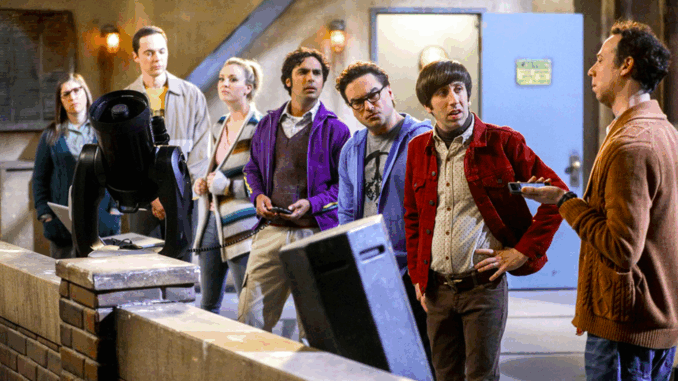
Making Science Funny—and Accurate
At first glance, The Big Bang Theory might seem like a typical sitcom built around quirky characters and classic odd-couple humor. But what made it stand apart from the beginning was its genuine embrace of science—not just as a backdrop, but as a core part of the show’s identity. From complex equations scribbled on whiteboards to intense discussions about string theory, the show did something few comedies dared to attempt: it treated real science seriously, even while laughing along the way.
Yet few fans realize just how much effort went into making sure that the science behind Sheldon, Leonard, Raj, and Howard was not only accurate but deeply rooted in real-world research and theory.
Enter David Saltzberg: The Show’s Science Guru
Behind nearly every whiteboard equation and technical term in The Big Bang Theory was Dr. David Saltzberg, a UCLA physicist specializing in experimental particle physics. As the show’s scientific consultant for all 12 seasons, Saltzberg reviewed scripts, provided background materials, and crafted the chalkboard content that appeared in lab scenes and apartments.
He ensured that what Sheldon claimed was a “bosonic string” really was a bosonic string, and that the equations in the background weren’t just random symbols—but solutions and diagrams relevant to current theoretical physics.
What’s remarkable is how seamlessly these elements blended into the comedy. To most viewers, the science was a form of set dressing. But for those in the know—physicists, engineers, and STEM students—it was a treasure trove of insider references.
Whiteboards That Meant Something
:max_bytes(150000):strip_icc():focal(1109x229:1111x231)/Big-Bang-Theory-Cast-02-100722-8e07b0b6bcb1481a89918995da4ed816.jpg)
If you paused the show at the right moment, you’d often find real physics problems worked out in detail—solutions to equations from quantum mechanics, references to Higgs bosons, or diagrams from astrophysics papers.
In fact, several whiteboards featured legitimate, unsolved problems from current research, used by Saltzberg as Easter eggs for academics. In one episode, the equation for the energy levels of a hydrogen atom in a magnetic field appeared on the board behind Sheldon. In another, Feynman diagrams were used to explain particle interactions.
The most hardcore fans even made Reddit threads trying to solve the whiteboard puzzles from each episode. In this sense, The Big Bang Theory became one of the only sitcoms in history with a cult following among physicists.
More Than Physics: Biology, Engineering, and Spaceflight
While physics was front and center—thanks to Sheldon and Leonard—other scientific disciplines weren’t neglected. Bernadette brought microbiology into the spotlight, even if her role often revolved around humor about germs or her pharmaceutical job.
Howard, despite being mocked for “only” having a master’s degree, represented aerospace engineering. His storylines often referenced real NASA missions, especially in Season 5 and 6, when he trains and flies to the International Space Station.
The ISS sequence wasn’t just a comedic arc—it drew heavily from actual astronaut training protocols and mission details. Saltzberg again worked with the writers to ensure that details about zero gravity, docking sequences, and space toilet malfunctions were both accurate and funny.
Guest Stars Who Added Credibility
Another way the show underscored its science-first approach was through guest appearances by real scientists. Physicist and cosmologist Stephen Hawking appeared multiple times, playing a fictionalized version of himself and even outwitting Sheldon.
Other guests included astronaut Buzz Aldrin, astrophysicist Neil deGrasse Tyson, and science communicator Bill Nye. These weren’t just celebrity cameos—they were meaningful nods to the STEM community.
By giving these figures space within the narrative, the show sent a clear message: science is not only important, but it’s also cool.
The Science That Went Viral
One of the most iconic science jokes in the show—Sheldon and Leonard arguing over loop quantum gravity vs. string theory—is more than just technobabble. It reflects a real, ongoing debate in theoretical physics.
String theory posits that the universe is made of tiny vibrating strings. Loop quantum gravity suggests a different structure to spacetime. These are actual frameworks that real scientists spend their careers developing. To incorporate them into sitcom banter—successfully!—is an incredible achievement.
Even Sheldon’s “fun with flags” segments, while played for laughs, showed respect for academic knowledge, no matter how niche or obscure.
Science as Character Development
Perhaps the most subtle achievement of The Big Bang Theory’s science is how it shaped the characters. Sheldon’s obsession with theoretical purity, Leonard’s more practical experimental physics, Raj’s love for space, and Howard’s design work for astronauts—each scientific focus matched their personality.
It wasn’t just that the show had scientists—it had scientists whose disciplines reflected their inner lives. That level of character integration is rare in any show, let alone one that consistently topped ratings for over a decade.
Conclusion: A Sitcom That Respected Its Subject
In a media landscape where science is often either ignored, misrepresented, or used as a plot device, The Big Bang Theory treated it with respect and authenticity. The show made it clear: intelligence can be funny, curiosity can be cool, and scientists can be as complex, lovable, and ridiculous as anyone else.
Thanks to Dr. David Saltzberg and a team of writers who weren’t afraid to embrace the nerdy, The Big Bang Theory became more than just a sitcom—it became an unlikely ambassador for science in pop culture.
